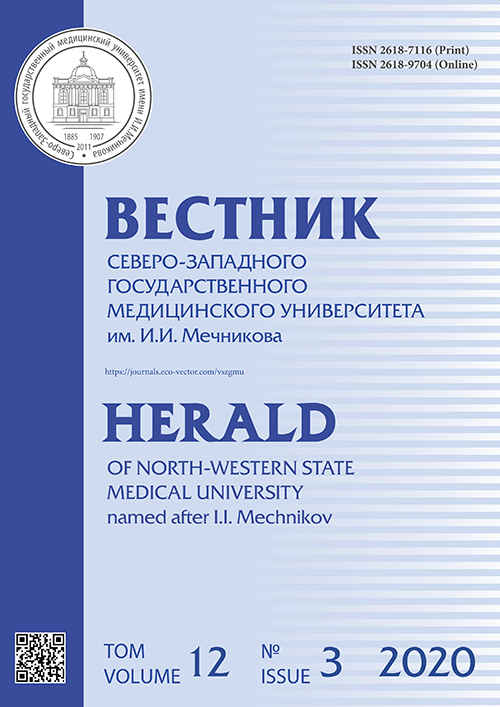剖宫产后分离ESKAPE组病原体子宫内膜异位症的内科治疗的预后和有效性
- 作者: Korobkov N.A.1, Bakulina N.V.1, Kakhiani E.I.1
-
隶属关系:
- North-Western State Medical University named after I.I. Mechnikov
- 期: 卷 12, 编号 3 (2020)
- 页面: 35-40
- 栏目: Original study article
- ##submission.dateSubmitted##: 02.07.2020
- ##submission.dateAccepted##: 16.08.2020
- ##submission.datePublished##: 20.12.2020
- URL: https://journals.eco-vector.com/vszgmu/article/view/34916
- DOI: https://doi.org/10.17816/mechnikov34916
- ID: 34916
如何引用文章
详细
目的是确定剖宫产后子宫内膜炎中耐药性ESKAPE病原体(rESKAPE)分离的频率,评估疾病的预后以及分离多药耐药性病原体的初步经验性抗菌治疗的结果。
方法。对圣彼得堡剖宫产后子宫内膜炎的所有病例进行回顾性分析。学习期间:2008年9月-
2019年9月
主要结果。剖宫产术后子宫内膜炎255例,其中68例(26.7%)是由rESKAPE组的病原体引起的。
患有由rESKAPE病原体引起的子宫内膜炎的产妇中,开具初始经验性抗菌药物治疗的临床失败率要高于其他病因的子宫内膜炎(p = 0.0012);感染过程的严重过程,具有其泛化和子宫切除术的威胁(p < 0.05)。
结论。由rESKAPE-病原体引起的腹部分娩后的内膜炎,与不利的疾病预测和抗微生物治疗不起作用的高风险有关。
全文:
绪论
虽然由ESKAPE病原体引起的感染(E. faecium, S. aureus, K. pneumoniae 和 E. coli, A. baumannii, P. aeruginosa, Enterobacter spp) 最近,具有多药
耐药性的人已被公认为严重的健康
问题[1-3],其在产后感染发展中的作用仍然未知。到目前为止,由耐受性ESKAPE病原体(ESKAPE)引起的传染性疾病的重点研究很少,而且一般来说也很少,根据特护和复苏科病人的数据[4, 5]。不同国家进行的研究表明,由rESKAPE病原体引起的感染与更高的死亡率,住院时间的增加和治疗费用的增加有关[2]。
这项研究的目的是确定剖宫产(CS)后子宫内膜炎中rESKAPE病原体分离的
频率,评估疾病的预后以及在存在多重耐药性病原体的情况下初步经验性抗菌治疗的结果。
材料与方法
进行了一项回顾性观察性多中心研究。主要临床部位为SPbGBUZ“城市马林斯基医院”和圣彼得堡的产科医院。研究
期间:2008年9月-2019年9月,在此
期间,马林斯基市立医院妇科,并在
CS后接受了225例产妇的子宫内膜炎的
诊断。
根据本研究的目的,将所有产后妇女分为两组:由rESKAPE病原体引起的子宫内膜炎和由ESKAPE组的易感菌株引起的子宫内膜炎。为了评估由rESKAPE组病原体引起的CS后经验性抗菌药物治疗子宫内膜炎的预后和有效性,在各组之间进行了比较。
根据文献[1-5]中的描述rESKAPE组的病原体已被标记。确定对rESKAPE病原体的抗性的标准如下:耐万古霉素E. faecium
(VRE),耐甲氧西林的菌株 S. aureus (MRSA),
K. pneumoniae和E. coli,产生广谱
β-内酰胺酶(ESBL+),耐碳青霉烯 A. baumannii(Carb-R),耐碳青霉烯和喹诺酮
P. aeruginosa 和和产生ESBL的菌株 Enterobacter。
使用经典的培养物诊断方法进行细菌
鉴定,并使用质谱法进行确认。易感性苯唑西林S. aureus在含有头孢西丁(30 mcg)的光盘上进行测试。多元聚合酶链反应(PCR)的结果证实MRSA的存在。对于革兰氏阴性细菌,使用带有和不带有头孢噻肟,头孢他啶和克拉维酸的两个圆盘的联合协同试验,证实了ESBL。In vitroESBL分离物的敏感性是在自动Vitek分析仪上使用AST-N156卡(bioMérieux,Marcy-L'Etoile,法国)与解释性控制点建立的。对vancomician为 Enterococcus spp敏感性是在Vitek分析仪(AST-P586卡)上确定的,检测编码糖肽抗性的van基因,也使用多引物进行聚合酶链式反应。中度抗药性和抗药性病原体被归入非敏感菌株组。
由于对研究指标的非参数研究,使用Mann-Whitney检验比较了患者研究样品中的定量指标值。为了分析定性参数的
差异,使用卡方检验。
通过计算Spearman相关系数,通过相关分析,确定了子宫内膜炎病程特征与子宫内膜炎病原体抗生素耐药菌株的存在之间的关系。
当无效假设(alpha)的统计显着性水平的阈值未达到等于0.05时,认为差异具有统计学意义。
结果
整个研究期间,对rESKAPE病原体引起的CS后的225例子宫内膜炎病例中的68例
(26.7%)进行了验证。所研究的产科医院中,这些感染均未反映任何医院内暴发。从耐多药的rESKAPE组中没有同时分离出两种或两种以上细菌的病例。
图显示了rESKAPE分离株的数量及其对抗生素敏感的分离株的数量。
剖宫产术后子宫内膜炎分离菌对抗菌药物的敏感性 (绝对数) Sensitivity of isolates to antimicrobial agents in endometritis after cesarean section (absolute number)
分离的rESKAPE组的多药耐药病原
体中,革兰氏阴性病原体占主导地位-占68例中的57例(占83.8%),而革兰氏阳性病原体-在68例中占11例(16.2%)。
领先地位属于 E. coli — 68位中的
25例(36.8%)由rESKAPE病原体引起的子宫内膜炎。几乎一半-52之25(48.1%)-
分离的大肠杆菌是ESBL的生产者。
由rESKAPE病原体引起的每四个子宫内膜炎中-68个病例中有17个(25.0%)-
肠杆菌属多耐药菌株(E. cloacae和
E. aerogenes)Enterobacteriaceae科。肠杆菌的特征在于敏感菌株的比例最小-24位中有7位(29.2%)。
日益迫切的问题是肺炎克雷伯菌K.pneumoniae参与了产褥期感染的发展,这是由于病原学意义的增强和它们对所用抗生素耐药性表型的恶化所致。根据我们的资料,多抗性klebsiell隔离比大肠杆菌少,但其频率在频率上是可比的Enterobacter spp。 Klebsiella spp. 份额
(BLRS+)占所有分离的克雷伯菌的1/3。
耐万古霉素的比例 E. faecium (VRE)
占33.3%(12位中有4位),甲氧西林敏感菌株
S. aureus (MSSA) — 63.2%(19位中有
12位),MRSA-36.8%(19位中有7位)。
rESCAPE组的非发酵革兰氏阴性菌的检出频率极低。因此,耐碳青霉烯 A. baum annii(Carb-R),耐碳青霉烯和喹诺酮 P. aeruginosa在CS后子宫内膜炎的病因中起主要作用。
因此,与CS术后女性术后大量最著名的术后感染病原体一起,对多药耐药的rESKAPE病原体的重要性也在增加。
与疾病相比,分离出rESKAPE病原体后子宫内膜炎的临床表现平均时间更短由其他微生物引起的(3.1±0.7天对4.9±1.1天,
p < 0.05)(表1)。由rESKAPE组病原体引起的子宫内膜异位症产妇的平均住院
时间更长(14.9±3.5天和9.1±2.2天,
p = 0.0006)。
表 1 / Table 1
术后内膜炎临床宣言时间和住院治疗时间,M ± m
The timing of the clinical manifestation of postoperative endometritis and the duration of inpatient treatment, M ± m
指标 | 未鉴定出rESKAPE病原体的子宫 n = 187 | 已鉴定出rESKAPE病原体的 n = 68 |
子宫内膜炎术后临床表现的持续时间,天 | 4.9 ± 1.1 | 3.1 ± 0.7* |
住院时间,天 | 9.1 ± 2.2 | 14.9 ± 3.5* |
注:*根据Mann-Whitney检验,与未鉴定出rESKAPE病原体的患者组的参数相比,在p < 0.05时,
差异具有统计学意义。
由rESKAPE引起的子宫内膜炎患者出现全身性炎症反应的严重症状伴感染泛滥-分别为17位(25.0%)与12位(6.4%)(p = 0.0012),与具有不同病因的子宫内膜炎患者组相比,该组的治疗效果也更显着统计学上的差异-24例(35.3%)对27例(14.4%)(p = 0.008)(表2)。
表 2 / Table 2
术后子宫内膜炎治疗效果的指标,M ± m
The indicators of the effectiveness of treating endometritis after cesarean section, M ± m
指标 | 已鉴定出rESKAPE病原体的子宫内膜炎患者 n = 68 | 未鉴定出rESKAPE病原体的子宫内膜炎患者 n = 187 | ||
绝对 | % | 绝对 | % | |
感染的泛化 | 17 | 25.0 | 12 | 6.4* |
治疗失败 | 24 | 35.3 | 27 | 14.4* |
注:*与通过卡方检验鉴定出rESKAPE病原体的患者组的指标相比,差异在p < 0.05上具有统计
学意义。
因此,在由rESKAPE病原体引起的子宫内膜炎的产妇中,最常见的情况是,在开始进行实验性抗微生物治疗时,感染过程更为严重,临床失败。
临床病程与治疗产褥疮的相关分析,以及从代谢产物中分离出rESKAPE病原体的结果表明,子宫内膜炎病原体的多抗性菌株的存在是该病病程和预后的可靠预测指标。从表3中可以看到多药耐药病原体的分离与中等强度之间的直接统计显着相关性与诸如顺应性治疗的持续
时间(R = 0.377;p = 0.017),
改变抗生素化学疗法的频率(R = 0.434;
p = 0.0012),转移次数到一家观察医院(R = 0.521;p < 0.001),感染的发生频率(R = 0.537;p = 0.022),子宫切除术的频率(R = 0.428;p < 0.001)和住院时间(R = 0.461;p < 0.001)。
表 3 / Table 3
多抗药性兴奋剂对剖腹产后内膜临床流动的影响以及该药的疗效
The effect of multiresistant pathogens on the clinical course of endometritis after cesarean section
and the effectiveness of etiotropic treatment
因素 | 斯皮尔曼相关系数 | p级 |
总体治疗时间 | 0.377 | 0.017 |
抗菌化学疗法的变化 | 0.434 | 0.0012 |
转到观察医院(妇产医院不采取保守治疗) | 0.521 | <0.001 |
感染的泛化 | 0.537 | 0.022 |
子宫切除术 | 0.428 | 0.0009 |
住院时间 | 0.461 | <0.001 |
因此,获得的数据表明,病原体的抗生素抗性使治疗结果恶化,导致抗菌治疗的持续时间和住院时间的增加。
讨论
这项对CS后产妇子宫内膜炎女性的回顾性多中心研究是对与rESKAPE感染相关的产科术后感染和炎性并发症的流行病学特征和预后的区域分析,以及该患者队列中标准抗生素处方不足对治疗效果的影响。
所有研究过的rESKAPE微生物中,KES组最常见的分离株(Klebsiella, Enterobacter,Serratia)。这是ESBL的生产者。
这些病原微生物越来越多地成为感染的病原体,这些感染在提供医疗服务期间发展且与不良预后有关[6]。我们的研究中,只有两种情况K. pneumoniae毒株,就产生碳青霉烯酶,其他研究相反,在这些研究中,这些病原体更为常见并造成治疗
困难[10]。
随着腹部分娩后子宫内膜炎的发展,我们发现了四种对万古霉素耐药的菌株E. faecium和七个MRSA菌株。因此,
这些革兰氏阳性球菌问题不大,比克棍
Enterobacteriaceae科,至少在圣彼
得堡。其他作者引用了产科患者中较高的MRSA发生率[7]。
已经表明,分离自具有子宫内膜炎的产妇的肠杆菌的结构是多种多样的,其中
E. coli(发现于每三个分娩妇女中)。
其中一半是超广谱β-内酰胺酶的生产者。
考虑到大肠杆菌在妇产科医院实施产后感染的巨大动力学意义,我们认为,这种
微生物也应包括在ESKAPE病原体组中。
但是,应该注意根据许多研究,感染这种感染的流行病学和危险因素与其他产生ESBL的细菌Enterobacteriaceae不同,
例如K. pneumoniae(ESBL+)[8]。虽然住院期间时水平传输频率K. pneumoniae (ESBL+)很高,E. coli(ESBL+)的水平传播是不可能的[9]。
充分治疗抗生素至关重要。但是,
目前有少量抗菌药物可用于治疗由多药耐药性微生物引起的感染。在我们研究中包括的产妇几乎完全没有的情况下,
P. aeruginosa (Carb-R)和A. baumannii (Carb-R)。碳青霉烯是首选药物由属微生
物引起的Enterobacteriaceae科,生产ESBL。第二类药物可以是蜂胶或某些氨
基酸,但在哺乳期间禁止使用这些
抗生素。
当分析CS后对女性子宫内膜炎的初步经验治疗后,发现rESKAPE病原体的分离是该病病程和预后不良的危险因素。
发现病原体的多药耐药性使抗菌治疗的结果恶化,延长了在产科医院的住院时间,
并总体上恶化了疾病的预后。
分离出子宫内膜炎rESKAPE病原体的可能性与导致子宫泛化和切除的感染过程的严重程度之间存在许多统计学上显着的相关性。
结论
根据研究结果,发现由rESKAPE病原体引起的腹部分娩后子宫内膜炎导致不良的预后,并且由于接受抗生素治疗而接受手术治疗(子宫切除术)的风险很高。
因此,从医院流行病学的角度来看,对于孕妇和分娩妇女的分层,有必要进一步监测rESKAPE组携带多重耐药病原体的主要和次要危险因素,这将允许采取有效措施预防和治疗术后感染和炎症并发症。
作者简介
Nikolay Korobkov
North-Western State Medical University named after I.I. Mechnikov
编辑信件的主要联系方式.
Email: nikolai_korobkov@mail.ru
ORCID iD: 0000-0001-7279-2535
доцент кафедры акушерства и гинекологии
俄罗斯联邦, Saint PetersburgN. Bakulina
North-Western State Medical University named after I.I. Mechnikov
Email: nv_bakulina@mail.ru
ORCID iD: 0000-0003-4075-4096
SPIN 代码: 9503-8950
Scopus 作者 ID: 7201739080
Researcher ID: N-7299-2014
http://www.researcherid.com/rid/N-7299-2014
д.м.н., проф., зав. каф. терапии и клинической фармакологии
俄罗斯联邦, Saint-PetersburgEkaterina Kakhiani
North-Western State Medical University named after I.I. Mechnikov
Email: dr.ekaterina@mail.ru
д.м.н., профессор, декан педиатрического факультета, зав. кафедрой акушерства и гинекологии имени С.Н. Давыдова
俄罗斯联邦, Saint Petersburg参考
- De Socio GV, Rubbioni P, Botta D, et al. Measurement and prediction of antimicrobial resistance in bloodstream infections by ESKAPE and Escherichia coli pathogens. J Glob Antimicrob Resist. 2019;19:154-160. https://doi.org/10.1016/j.jgar.2019.05.013.
- Mulani MS, Kamble EE, Kumkar SN, et al. Emerging strategies to combat ESKAPE pathogens in the era of antimicrobial resistance: A review. Front Microbiol. 2019;10:539-545. https://doi.org/10.3389/fmicb.2019.00539.
- Santajit S, Indrawattana N. Mechanisms of antimicrobial resistance in ESKAPE pathogens. Biomed Res Int. 2016;2016: 2475067. https://doi.org/10.1155/2016/2475067.
- Sandiumenge A, Lisboa T, Gomez F, et al. Effect of antibiotic diversity on ventilator-associated pneumonia caused by ESKAPE organisms. Chest. 2011;140(3):643-651. https://doi.org/10.1378/chest.11-0462.
- Sandiumenge A, Rello J. Ventilator-associated pneumonia caused by ESKAPE organisms: Cause, clinical features, and management. Curr Opin Pulm Med. 2012;18(3):187-193. https://doi.org/10.1097/MCP.0b013 e328351f974.
- Chaintarli K, Lenglet A, Beauzile BD, et al. High prevalence of ESBL-positive bacteria in an obstetrics emergency hospital and neonatal care unit — Haiti, 2016. Infect Control Hosp Epidemiol. 2018;39(11):1381-1383. https://doi.org/10.1017/ice.2018.213.
- Udo EE, Al-Sweih N. Dominance of community-associated methicillin-resistant Staphylococcus aureus clones in a maternity hospital. PloS One. 2017;12(6):e0179563. https://doi.org/10.1371/journal.pone.0179563.
- Rodríguez-Bano J, Navarro MD, Romero L, et al. Clinical and molecular epidemiology of extended-spectrum β-lactamase — producing Escherichia coli as a cause of nosocomial infection or colonization: Implications for control. Clinical Infectious Diseases. 2006;42(1):37-45. https://doi.org/10.1086/498519.
- Rodríguez-Bano J, Navarro MD, Romero L, et al. Epidemiology and clinical features of infections caused by extended-spectrum beta-lactamase-producing Escherichia coli in nonhospitalized patients. J Clin Microbiol. 2004;42(3):1089-1094. https://doi.org/10.1128/JCM.42.3. 1089-1094.2004.
- Kramarov SO, Yevtushenko VV. Carbapenems in clinical practice. Actual Infectology. 2019;7(2):57-62. https://doi.org/10.22141/2312-413x.7.2.2019.161149.
补充文件







